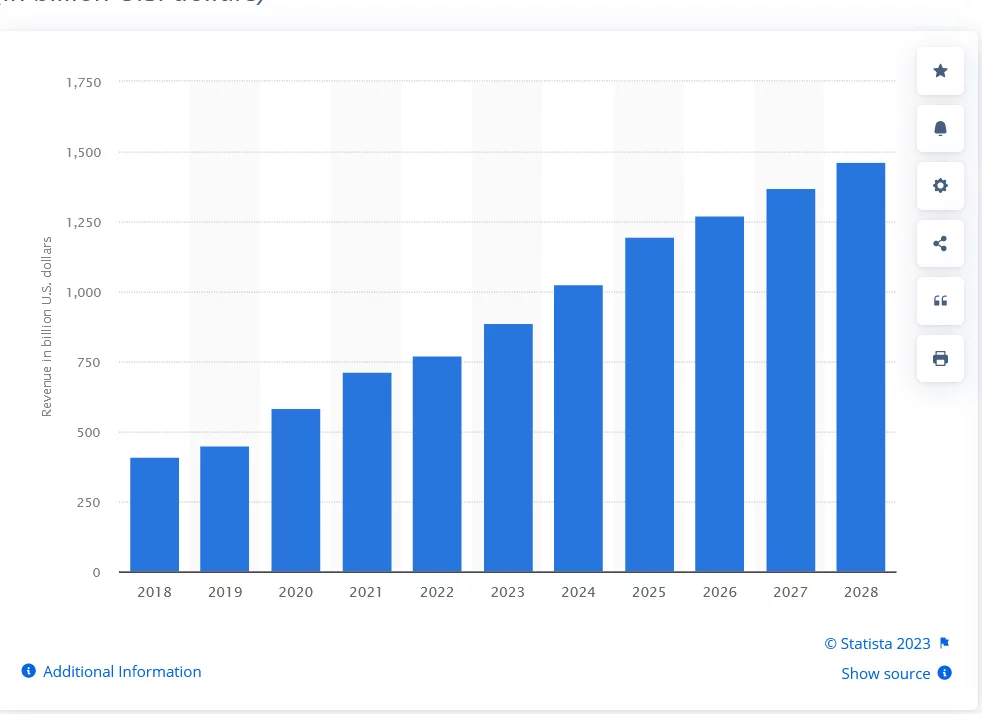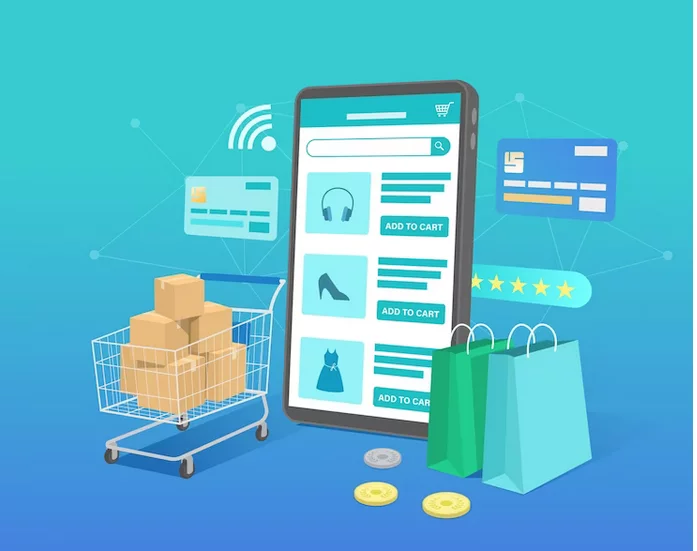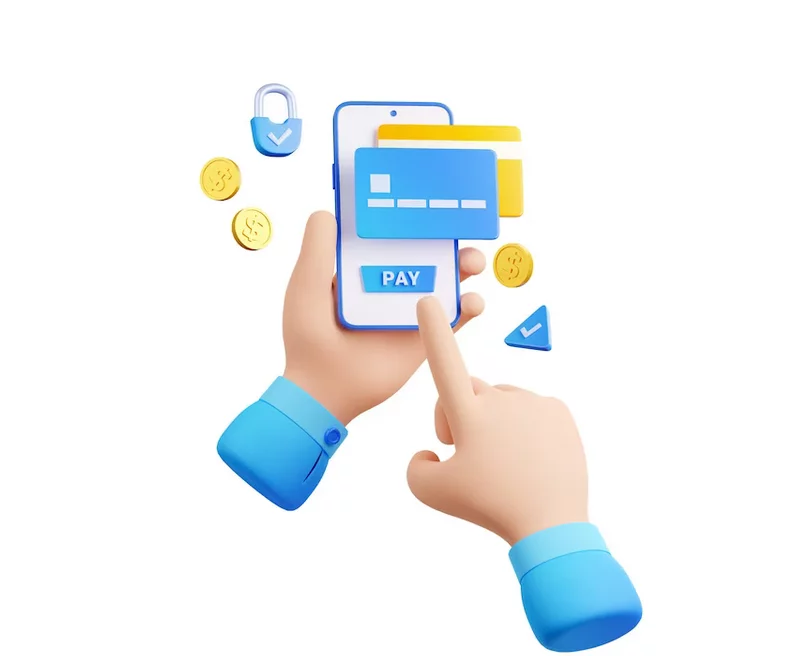The Covid-19 pandemic completely altered the landscape for online retailers, and the change in consumer behavior is here to stay. The retail industry has significantly profited from online sales since it has allowed the traditional sector to reach out to more customers without compromising the in-person shopping experience.
The same is true for shops of all shapes and sizes; ecommerce accommodates a wide range of goods, from clothing to shoes to truck parts. Online sales can be advantageous for all stakeholders involved in the retail chain, including customers, suppliers, and manufacturers. Due to the complexity of managing such a large market, ecommerce businesses must rely on the advantages of ecommerce trends.

Source: Revenue of the e-commerce industry in the U.S. 2018-2028
The popularity of ecommerce is further boosted by the fact that more and more merchants are coming to recognize its efficacy. This was never as apparent as during the pandemic, when customers rushed to online retailers as the government imposed lockdowns and physical store sales were severely restricted.
Those who continue to oppose the idea run the risk of losing their company if they don’t accept it. Top ecommerce platforms have grown in popularity among online sellers due to this ecommerce trend.
The Ecommerce Market: What Is It?
Ecommerce serves as a bridge between two critical segments of the online business market. The first segment is platforms, which are among the world’s most widely used online services. The ecommerce marketing segment of the Google search engine receives the most web traffic. The fastest-growing ecommerce markets are China, Japan, the USA, and India.
The majority of ecommerce business models fall into one of four categories. If you’re considering starting an online store but need to learn more about the basic e-commerce categories. Your ability to think creatively about potential opportunities and risks will increase when you know the context in which your big idea sits.
- Business to consumer, or B2C
- Business-to-business, or B2B
- Consumer to business, or C2B
- Consumer to consumer, or C2C
Well-known brick-and-mortar companies have improved their online offerings due to all the buzz surrounding eCommerce. A result of the heightened competition is some ecommerce trends that are truly creative.
The future of online retail sales is bright, but to compete in 2023, you’ll need to adapt to and include some of these eCommerce trends.
Top Online Retail Ecommerce Trends for 2024
Over the past few years, ecommerce web development has experienced remarkable growth & adjustments. The general company policy is driven by more features, more sophisticated components, and a greater customer-oriented attitude listed below:
1. Purchase Now, Pay Later (BNPL)

Customers who use the Buy Now, Pay Later payment option can buy goods and pay for them over time in the set, regular installments. Because BNPL agreements are frequently interest-free, consumers choose this option over credit card payments.
The well-known BNPL transaction platforms include Klarna, PayPal, Afterpay, Affirm, and Sezzle. In 2023, Mastercard plans to enter the BNPL market.
Because the BNPL approach has been demonstrated to:
- Decrease the rate of cart abandonment
- Increase sales
- Speed up the checkout process
- Increase order size
Pro Tip: Shopify provides its users with a BNPL plugin called Shop Pay Installments. You will only need to incorporate a third-party BNPL supplier if Shopify is your eCommerce platform.
2. Loyalty Initiatives

Because they reward loyal clients for making repeated purchases, eCommerce loyalty programs are incredibly popular. They get benefits like cash back, savings, coupons for their next purchase, and freebies.
In the meantime, businesses like Starbucks can use the information from their loyalty programs to comprehend the purchasing habits of their clients and give them customized deals based on their individual purchase histories
Benefits of loyalty programs include:
- Boosting word-of-mouth sales
- Improving client retention
- Increasing sales
- Improving overall customer experience
- Loyalty programs also provide useful information about consumer behavior
Remark: It can be successful if loyalty programs account for 20% of revenues.
3. Sustainability

Unbelievable as it may seem, being environmentally friendly is likely to affect internet sales. Because many consumers claim to be influenced by environmental concerns while purchasing, brands are expected to ride the big green consumerism wave.
A major indication that online sellers must step up and follow environmentally friendly procedures is the resurgence of interest in environmental sustainability. Companies can achieve this by ensuring a greener online marketplace by limiting their product sourcing to fair-trade firms.
The development of millennials as a significant consumer group influences green consumption. This generation is passionate about seeking environmentally friendly items. The desire for eco-friendly items is pushing e-commerce businesses to adopt sustainable practices.
Green Consumerism’s Best Features
- Eco-friendly methods are thought to increase internet sales. Environmental considerations may have an impact on consumers’ shopping decisions.
- Fair-trade groups’ product procurement can assist businesses in reducing their environmental impact.
Apple and Amazon, the two eCommerce behemoths, are making significant investments in sustainability.
The Climate Pledge Fund, an initiative with a $2 billion budget started by Amazon, supports businesses committed to achieving net-zero carbon emissions by 2040.
Over five years, Apple reduced carbon emissions by 40%. The business has also disclosed that 175 suppliers will use renewable energy to cut the annual generation of greenhouse gases.
4. The Metaverse and other gaming platforms’ sales

The parent corporation of Facebook has changed its name to “Meta,” and has introduces Metaverse, a Virtual Reality setting where users may interact and play games. For ecommerce enterprises, this represents a potent new marketing avenue. Facebook has also launched its new Horizon Worlds platform.
Although in-world ecommerce and advertising have yet to be quite ready, they will be short!
Global brands like Nike, Gucci, Coca-Cola, and Vans intend to offer consumers virtual goods with their logos. Other gaming platforms will, in the meantime, allow eCommerce sales on their platforms. For instance, fashion label Balenciaga and video game developer Epic Games recently collaborated to introduce their Fortnite clothing line.
Additionally, Nike has introduced Nikeland on the Roblox gaming network, where users can purchase virtual Nike apparel for their virtual characters.
Benefits of Metaverse for ecommerce:
- It gives considerable visibility, especially for attracting younger populations.
- Ripe with opportunity
5. Video Promotion

Online retailers use anything from explanatory product videos to video testimonials in their marketing campaigns because the video is huge in eCommerce. When you consider it, it makes perfect sense because ordering a product you’ve never seen before is made easier with video.
If a product has moving parts, you can see it in motion, get an idea of its size (which a snapshot might not communicate), and learn how it operates. Additionally, individuals tend to prefer watching videos to reading product descriptions.
Video marketing provides:
- Simple and engaging engagement
- The chance to provide genuine customer testimonials and provide social proof
- A decreased risk of expensive refunds because customers know what they’re getting.
Pro tip: You can find, gather, and post customer-generated review videos for your products using software platforms like VideoWise.
6. Influencer marketing and social commerce

Social media has changed from what it once was. It’s no longer a means of communication for people. Social media has developed as a tool for marketing, allowing companies to reach new target markets. “Buy buttons” have been added to social media platforms like Instagram and Facebook to enable retailers to sell there. Additionally, social media platforms have been linked with online retailers, allowing users to make purchases through the latter.
Most social media networks have been concentrating on attracting online buyers. But more crucially, social media has developed into a platform that allows for the best possible exposure of brands.
Exposure to social media increases consumer awareness of a good or service. And because users are becoming more and more influenced by social media. Because of this, using social marketing tactics would be beneficial for e-commerce businesses.
Social media platforms are used for direct product sales in social commerce. On social media sites like TikTok, Facebook, Instagram, Snapchat, and YouTube Shorts, short videos, paid commercials, and influencer marketing assist in influencing consumer decisions.cial media platforms are used for direct product sales in social commerce. On social media sites like TikTok, Facebook, Instagram, Snapchat, and Youtube Shorts, short videos, paid commercials, and influencer marketing assists in influencing consumer decisions.
Advantages of social commerce
- Brands can get followers and broaden their reach
- Social commerce enhances brand-to-consumer communication and customer engagement
- Social proof from influencers can increase sales
7. Commercial Live Streaming (Swipe up to Buy Now)

Have you ever stumbled across the Home Shopping Network when flipping through the TV stations in a hotel? You may have pondered who would purchase a pair of earrings from a stranger on television.
Well, the eCommerce industry is exploding with something similar! An emerging trend is live streaming commerce, in which brands (or influencers they’ve hired) generate live videos where their audience may engage with them while putting commercial products front and center. Additionally, they do more than merely mention those products and include a link in the description. Several video streaming services let users buy those things during a live feed.
The live-streaming business is fairly common in China and is beginning to spread to the United States. Brands can live stream content on their website, social media pages, mobile apps, or television. Here are a few instances of livestream commerce that was a success.
- TikTok and Walmart

Recently, Walmart and TikTok worked together to create a live-streamed shopping event. With only one click, viewers could add things to their shopping cart. The event attracted 7 times more viewers than expected and increased the number of followers by 25%.
For its audience, Amazon has introduced a stand-alone livestreaming platform named “Amazon Live.” On the platform, influencers and curators regularly present product-focused livestreams that may be purchased, along with exclusive deals.
For its customers, Amazon provides live-stream shopping. Additionally, viewers can ask questions about the products in the chat, which improves engagement and increases sales.
Facebook is experimenting with real-time shoppable videos, allowing users to watch and make purchases simultaneously. These videos feature product demonstrations from many different brands. Without leaving Facebook, viewers may try out new products, post queries, and place orders.
Advantages of live streaming business:
- Enhance client interaction
- Expand brand exposure
- Increase customer reach
8. mCommerce (Mobile Commerce)

A fancy term for eCommerce that is geared toward mobile users and makes it simpler for them to make purchases via smartphones and tablets is “mobile commerce” (also known as “mCommerce”).
As mobile traffic increases, many eCommerce organizations are developing mobile-first strategies. Peer-to-peer (P2P) mobile payment systems make it simpler than ever to transact business using a smartphone, and SMS (text-based) marketing makes it simpler to interact with clients and generate repeat business.
With the help of SMS marketing tools like LiveRecover, it is simple to communicate with customers via SMS, providing order details and lowering cart abandonment by nagging clients to finish their orders. Shopify stores can use LiveRecover.
Advantages of mCommerce
- Increase your customer base
- Daw in new clients who prefer utilizing mobile devices
- Promote repeat business with push notifications and SMS marketing
- Enable location-based customization
9. Image Search

Reverse image searches have been a popular feature for tech-savvy internet users on Google for years, but technology has advanced and now provides an entirely new eCommerce purchasing experience.
A customer can upload an image of an item they want to purchase. Google’s Multitask Unified Model algorithm (MUM) will show them many related products available for purchase. Google Lens and Google’s Multitask Unified Model (MUM) will be connected, enabling simple visual product searches.
If your eCommerce business model benefits from visual search, you should optimize your product descriptions and photos to adhere to MUM guidelines. This will enable direct purchasing and help them rank higher in searches.
The top ecommerce platforms are starting to provide visual search functionality that you can integrate into your website and mobile application. For instance, Magento’s Product Search Via Image Extension, whereas Shopify includes tools like Shopify’s Visual Search tools.
Advantages of visual search optimization:
- Customers can find your products
- It’s a terrific method to attract Gen-Z buyers.
10. Individualized Packaging

Let’s face it: as consumers, we confuse brand packaging with the actual brand. We are more inclined to make a buy if the package is attractive.
It is also true that most customers are more enthusiastic about things when they arrive in distinctive packaging. Therefore, it makes perfect sense for online retailers to personalize their product packaging. By doing this, their items will stand out.
If you want to alter the packaging for your products, you may do so by concentrating on certain packaging-related factors. You can draw attention to the strength and appeal of your packaging and the fact that it is environmentally friendly. This would help you further develop your brand.
Highlights of Customized Packaging
- Customers value personalized packaging because it helps products stand out from the competition.
- By concentrating on a product’s distinctive qualities, retailers may create superior packaging.
- Custom packaging helps establish a brand.
11. Multichannel Personalization

Selling now often involves a more personalized consumer experience. Due to its potential to enhance customer experience, this technique has grown commonplace among ecommerce businesses. But there are many ways to benefit from personalization, and imagine using this idea for multichannel marketing.
But what if you make it better by providing tailored interactions? The outcome can only be increased client loyalty and hence recurring business. A system like this ensures that every customer receives the same tailored brand experience regardless of the channel they choose. This eliminates the need to irritate your customers with pointless messages and guarantees that you only provide them with relevant experiences.
Many marketers, however, have yet to adopt the concept, which limits their capacity to provide a seamless individualized experience.
Advantages of Multichannel Personalization
- Personalization is becoming typical among e-commerce businesses.
- Personalization in multichannel sales encourages client retention and loyalty.
- The customer experience is improved via personalization.
- Most marketers have not yet embraced customization.
12. Better Processing of Payments

Whether a client likes it or not, payment processing is a necessary step in the conversion process and part of every customer’s journey. Until your cash register bell rings, a transaction is not a deal. Therefore, it makes no difference if you persuade a lead to make that transaction.
If a customer finds your checkout procedure cumbersome, that potential conversion can still be abandoned. This is especially true for startups, the majority of which are now starting to benefit from the best ecommerce software for small businesses, enabling them to process payments in several different ways.
One of the most often stated causes of shopping cart abandonment is a complex checkout process. Create a direct checkout experience with clear payment alternatives if you want your online store to be more competitive.
Local payment choices and combining all payments into one platform are advised for individuals who conduct business worldwide. Now, hiring the aid of a third-party service provider can be helpful if you run into regulatory roadblocks along the process.
Reasons for Setting the Cart Down During Checkout
- Too many additional costs – 60%
- Creating an account on the site is required -37%
- Too tricky/long of a checkout process -28%
- Failure to estimate the total cost of the order beforehand -23%
- Website crashed or experienced issues by 20%
- A site providing credit card information: -19% Untrust
- Delivery issues -18%
- Returns policy is inadequate -11%
- Lack of payment options – 8%
- Credit card declines -4%
Advantages of easy payment processing
- The transactional procedure is essential for conversion.
- Cart abandonment is a result of challenging checkout procedures.
- Simple payment methods help speed up checkout procedures.
Award-winning retail POS software for iOS and PC with customer loyalty, e-commerce, and inventory management features is the Most Popular Ecommerce Software Vend. With the ability to grow with your company, NetSuite ERP gives you complete, real-time management of all financial areas of your firm.
Built on Shopify’s engine, which provides over 99.97% uptime, Shopify Plus is an enterprise-level ecommerce platform for big-volume retailers. With the help of WooCommerce, any WordPress-powered website may become a fully functional online store. TradeGecko is an inventory management system that takes care of the tedious aspects of inventory management to focus on expanding your business.
13. Growing Use of AI in Ecommerce

Artificial intelligence (AI) is used by more businesses to streamline their procedures. And online retailers are hardly an exception.
Retail was one of the first industries to see the advantages of incorporating AI into their tech arsenal. It makes sense that online retailers will invest $7.3 billion in AI by 2022. Retailers’ desire to give customers a tailored experience is causing this rise.
These changes in AI spending demonstrate how keen retailers are to make investments to enhance their services. To date, customer service, sales, and marketing are some notable AI applications.
However, the application of AI is also advantageous in areas like forecasting and pricing. AI has a lot of potentials to improve the sales process. Ecommerce companies are urged to think about investing in AI technology in this context.
Additional AI Highlights
- AI is used by businesses to streamline workflows and procedures.
- By 2022, e-commerce businesses will invest 7.3 billion in AI.
- AI is being pushed by the need to improve customer experiences.
- AI applications can also enhance forecasting and pricing.
Conclusion:
The advent of ecommerce has effectively dismantled barriers, fostering greater interaction between customers and manufacturers.
This surge has introduced fresh opportunities for traders and consumers alike, presenting user-friendly mobile applications and sophisticated store catalogs that simplify the buying process.
These virtual storefronts established on ecommerce platforms have not only facilitated the proliferation of countless businesses but have also significantly bolstered employment opportunities.
FAQs on Ecommerce Trends:
Which ecommerce trend will be the biggest In 2024?
Using numerous online channels to provide a seamless online purchasing experience is predicted to be the largest ecommerce trend for 2024. Brands will use social media, marketing, online stores, data, and their commerce platforms to influence consumer decisions and cater to their online and offline needs.
Brands that can maximize omnichannel retail will be able to increase the number of online customers, provide them with a better shopping experience, and integrate this with their brick-and-mortar offers.
How can retail brands take advantage of these ecommerce trends in 2024?
Retail companies can provide a service that satisfies consumer wants in various ways. Designing an online shopping experience that customers love to interact with is feasible by using some of the features and services described on this list.
This is a fantastic approach to engage every customer on your commerce site and to help growth by offering innovative and cutting-edge ecommerce capabilities that your rivals do not.
To integrate any of these improvements, do you need a tech partner?
Yes you do need a tech partner that will cater to your needs of retail business. Over the years, Nestify has created a hosting platform that has helped improved several ecommerce websites for clients ranging from microbusinesses to global retailers. We helped them adapt to the most recent changes in this fast-changing industry by updating their ecommerce system to compete as they went global.
How does livestream shopping work?
Live streaming is a terrific technique to communicate with customers online and engage them in e-commerce. This online shop trend is a practical approach for many retailers to lower barriers to entry and increase consumer loyalty.
How do I choose which social media posts are best for ecommerce?
Find methods to incorporate your offering with well-known themes to achieve this. For instance, you may look at current Instagram trends to see if any organically mesh with your company’s goods or brand.
Knowing what’s popular on Instagram or during particular seasons, like Black Friday, will help you keep ahead of shopping trends and use online trends to attract customers. Monitor the material posted by your rivals and the success of the content you create to get extra inspiration.



